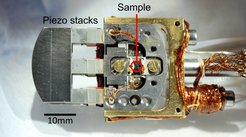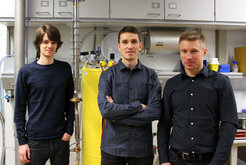Unconventional superconductor feeling the strain
One of the dreams of any physicist working on modern materials is to be able to make fine changes to their properties by applying some external, experimentally controlled stimulus. It is even better if the changes can be fine-tuned if necessary, but the range over which they can be made is as large as possible. A third important requirement is that whatever is done to the material keeps it as pristine as possible, and does not introduce any imperfections or disorder. These requirements are so stringent that meeting them all simultaneously sometimes seems like an unachievable dream, but in a paper appearing in the current issue of “Science”, Alexander Steppke, Lishan Zhao, Mark Barber and collaborators show that it can be done. Building on previous work by co-authors Clifford Hicks and Andy Mackenzie, the team applied previously unattainable levels of uniaxial pressure to a single crystal bar of the famous unconventional superconductor Sr2RuO4. The crystal’s response was extremely strong – its superconducting transition temperature increased by over a factor of two, and the magnetic field required to destroy the superconductivity increased by a factor of twenty.
Working in collaboration with Thomas Scaffidi and Steve Simon from the Theoretical Physics department at the University of Oxford, the team show that the new experiments might indicate a novel transition between two types of superconductivity that has been postulated but never observed, and the work is generating considerable interest. In fact, other teams of theoretical physicists in Hong Kong, Zürich and Cornell have also posted calculations based on the results on the physics preprint archive.
Whatever the outcome of the work in terms of understanding the superconductivity of Sr2RuO4, the new experiment has broader significance. The technique that we invented for this work should in principle be applicable to a wide range of other materials. For example, it has already been adapted by a team from University of California Irvine to dramatically alter the properties of the correlated insulator SmB6, opening the way to new classes of investigation of its topological properties. Our group is designing several pieces of improved apparatus to allow the new tuning methods to be used in many more experimental environments, and we are optimistic that further breakthrough experiments will become possible, both in-house and with our network of international collaborators.
AM, AS / CPfS



